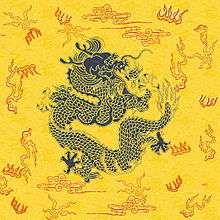Flag of the Qing dynasty
.svg.png) | |
| Name | Yellow Dragon Flag (黃龍旗) |
|---|---|
| Use |
National flag and ensign |
| Proportion | 5:8 |
| Adopted | 1889 |
| Design | Blue dragon on plain yellow, with a red pearl at the upper left corner. |
|
Variant flag of national flag Qing Dynasty | |
| Name | Early version of Yellow Dragon Flag |
| Use |
State and war flag, state and naval ensign |
| Proportion | 2:3[1] |
| Adopted | 1862 |
The flag of the Qing dynasty was an emblem adopted in the late 19th century featuring the Azure Dragon on a plain yellow field with the red flaming pearl of the three-legged crow in the upper left corner. It became the first national flag of China and is usually referred to as the "Yellow Dragon Flag" (simplified Chinese: 黄龙旗; traditional Chinese: 黃龍旗; pinyin: huáng lóng qí).
Ruling China from 1644 until the overthrow of the monarchy during the Xinhai Revolution, the Qing dynasty was the last imperial dynasty in China's history. Between 1889 and 1912, the dynasty represented itself with the dragon flag.
Design

Throughout the history of China's imperial dynasties, yellow was considered the royal color of successive Chinese emperors. The legendary first emperor of China was known as the Yellow Emperor (Chinese: 黃帝, Simplified Chinese: 黄帝). Members of the imperial family of China at that time were the only ones allowed to display the color yellow in buildings and on garments. The Emperor of China usually used a Chinese dragon as a symbol of his imperial power and strength. Generally, a five-clawed dragon was used for emperors only.
In Chinese culture, a flaming pearl is shown on top of the dragon's head. The pearl is associated with wealth, good luck, and prosperity.
The design of the flag was largely based on the Plain Yellow Banner of the Eight Banners.[2]
Triangular version (1862-1889)

The Arrow Incident of 1856 occurred as a result of Chinese civilian vessels flying foreign flags as the Qing dynasty had no official flag at the time.[3] In 1862, sailors from the Chinese and British navies clashed at Wuhan on the Yangtze River. In response to the British navy's claim of being unable to distinguish between Chinese governmental or navy ships and civilian vessels, Yixin (Prince Gong) urged Zeng Guofan to create a governmental flag for the Qing, and suggested use of a yellow dragon flag, which was also used as one of the Eight Banners of the Manchu as well as in the Chinese army. After due consideration, Zeng Guofan concluded that a square flag bore too close a resemblance to the Plain Yellow Banner of the Eight Banners with the potential to be viewed as an endorsement of the Eight Banners hierarchy, he instead removed one corner to create a triangular flag.[2]
The triangular version of the yellow dragon flag was restricted to naval and governmental use only, no civilian ships were permitted to fly the yellow pennant, and it never became the national flag.[4] However, on some diplomatic occasions and at international exhibitions, this flag was used to represent China.
Rectangular version (1889-1912)
In September 1881, when the two cruisers Chaoyong and Yangwei ordered from Birkenhead, England were sent to China, Li Hongzhang realized a triangular ensign was unique among naval flags of other countries. As a result, he petitioned the imperial court for permission and subsequently altered the triangular naval flag into a rectangular one.[5]
Seeing Western countries flying national flags on official occasions, Li Hongzhang also asked Empress Dowager Cixi to select a national flag for the Qing dynasty. Among the proposals for use of the Ba gua flag, the Yellow dragon flag and the Qilin flag, Cixi selected the Yellow dragon design. In 1888, the imperial court promulgated the naval flag as the Qing national flag.[6]
Influence
The notion of yellow as representative of Manchu ethnicity was used in the flags of the Five-coloured flag of the Republic of China and on the flag of the Empire of China, although in 1912 the former was challenged by Sun Yat-sen, who thought it inappropriate to use the traditional imperial color to represent Manchu ethnicity.[7] Also, mustard yellow was used in the flag of Manchukuo in deference to the Qing dynasty, on whose flag it was based.
The blue dragon was featured in the Twelve Symbols national emblem, which was the state emblem of China from 1913-1928.
Flags based on Qing dynasty flag
- Navy of Qing dynasty
Navy of Qing dynasty adopted the national flag in the canton of naval flags in 1909.[8]
|
|
|
|
|
|
- Chinese Eastern Railway
Flag of Chinese Eastern Railway adopted a combination of Qing dynasty and Russian flags. The flag was not updated until 1915.[9]
|
See also
References
- ↑ Dimension of first yellow dragon flag from Wuhan Custom Archive
- 1 2 施爱东 (Shi Aidong) (2011). Qing dragon flag flourished through 50 years of sorrow (哀旗不幸 怒旗不争 大清龙旗50年). 民族艺术. p. 6. (Chinese)
- ↑ 肖吟新 (Xiao Yinxin) (2002). The story of the Qing dynasty national flag (清代国旗的故事). 世纪. p. 63. (Chinese)
- ↑ "係為雇船捕盜而用,並未奏明定為萬年國旗", "[the flag] is used for ferry and policing, but is not explicitly designated as the permanent national flag", from 《北洋水師章程》(Regulations of the Beiyang Fleet) (Chinese)
- ↑ "今中國兵商各船日益加增,時與各國交接,自應重定旗式,以祟體制。應將兵船國旗改為長方式,照舊黃色,中畫青色飛龍。", "Nowadays the number of both Chinese military and commercial ships is growing. When our ships meet those of other nations they should display a flag based on a conformed system. [The government] should change the military flag to a pennant with an azure dragon in the middle",《北洋水師章程》(Regulations of the Beiyang Fleet) (Chinese)
- ↑ 《清朝国旗考》(Study on the Flag of Qing), 育民 (Chinese)
- ↑ "Story of the National Flag, official website of the Kuomintang". Retrieved 11 February 2014. (Chinese)
- ↑ Chinese Eastern Railway Company (China)
External links
![]() Media related to Flags of the Qing Dynasty at Wikimedia Commons
Media related to Flags of the Qing Dynasty at Wikimedia Commons
.svg.png)
.svg.png)
.svg.png)
.svg.png)
.svg.png)
.svg.png)
.svg.png)
.svg.png)